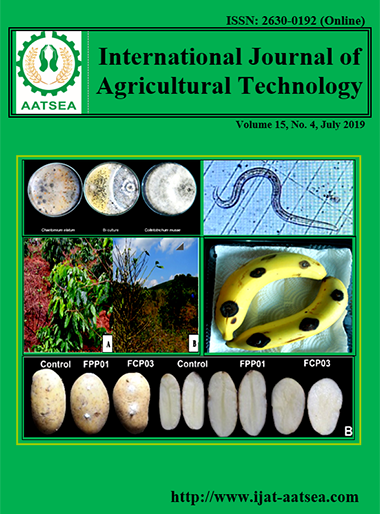The preliminary study of cell membrane stability of Pleurotus ostreatus (Jacq. ex Fr.) P. Kumm strains related to the production of fruiting body
Main Article Content
Abstract
One of the most widely cultivated edible mushroom in Indonesia is Pleurotus ostreatus (Jacq. Ex Fr.) P. Kumm or commonly called “white oyster mushroom”. The growth and fruit body formation of P. ostreatus is influenced by environmental factors, especially temperature. High temperature tended to cause disadvantages because it can reduce the rate of mushroom growth. Heat stress affects cell membrane function. The increased permeability and leakage of electrolyte out of the cell has been used as a measure of cell membrane stability (CMS) and as a screen test for stress tolerance. CMS can be done by measuring cell’s relative injury (RI). Based on result, the lowest damage was found in InaCC F10 strain (31,21% RI), while the highest damage was found in InaCC F209 strain (52,98%). Result stated that different types of P. ostreatus strains significantly affected the stability of the fungal cell membrane. Further test stated that InaCC F10 [RI=31,21(a)] and InaCC F216 [RI=32,11(a)] strains were the same effect and the lowest damage levels, while InaCC F196 [RI=47,18(c)] and InaCC F209 [RI=52,98(c)] strains were the same effect, but the highest damage levels. The biological efficiency (BE) was observed to determine the productivity of P. ostreatus strains. Result stated that different types of P. ostreatus strains significantly affected the productivity of mushroom. Further test stated that InaCC F10 was the highest productivity [BE=21.62% (c)], while the lowest productivity was found in InaCC F196 strain [BE=11.10%(a)] and InaCC F131 strain [BE=12,46%(a)].
Article Details

This work is licensed under a Creative Commons Attribution-NonCommercial-NoDerivatives 4.0 International License.
References
Agarie, S., Hanaoka, N., Kubota, F., Agata, W. and Kaufman, P. B. (1995). Measurement of cell membrane stability evaluated by electrolyte leakage as a drought and heat tolerance test in rice (Oryza sativa L.). Journal of The Faculty of Agriculture Kyushu University, 40:233-240.
Ali, M., A., Abbas, A., Niaz, S., Zulkiffal, M. and Ali, S. (2009). Morpho-physiological criteria for drought tolerance in Sorghum (Sorghum bicolor) at seedling and post-anthesis stages. International Journal of Agriculture and Biology, 11:674-680.
Aliffahrana, R. (2012). Respon pertumbuhan jamur tiram putih (Pleurotus ostreatus) pada dua kondisi temperatur dan kelembapan berbeda. (Bachelor Thesis). Institut Pertanian Bogor, Indonesia.
Apetorgbor, A. K., Apetorgbor, M. M. and Derkyi, N. S. A. (2015). Comparative studies on growth and yield of oil palm mushroom, Volvariella volvacea (Bull. Ex. Fr.) Sing. On different substrates. Greener Journal of Agricultural Sciences, 5:177-189.
Arvin, M. J. and Donelly, D. J. (2008). Screening potato cultivars and wild species to abiotic stresses using an electrolyte leakage bioassay. Journal of Agricultural Science and Technology, 10:33-42.
Bai, S. and Abraham, T. E. (2001). Biosorption of Cr (VI) from aqueos solution by Rhizopus nigricans. Bioresource Technology, 79:72-81.
Bajji, M., Kinet, J. M. and Lutts, S. (2002). The use of the electrolyte leakage method for assessing cell membrane stability as a water stress tolerance test in durum wheat. Plant Growth Regulator, 36:61-70.
Beltrano, J. and Ronco, M. G. (2008). Improved tolerance of wheat plants (Triticum aestivum L.) to drought stress and rewatering by the arbuscular mycorrhizal fungus Glomus claroideum: Effect on growth and cell membrane stability. Brazilian Journal of Plant Physiology, 20:29-37.
El Basyoni, I., Saadalla, M., Baenziger, S., Bockelman, H. and Morsy, S. (2017). Cell membrane stability and association mapping for drought and heat tolerance in a worldwide wheat collection. Sustainability, 9:1-16.
Fernandes, A., Barros, L., Martins, A., Herbert, P. and Ferreira, I. C. F. R. (2015). Nutritional characterization of Pleurotus ostreatus (Jacq. ex Fr.) P. Kumm, produced using paper scraps as substrates. Food Chemistry, 169:396-400.
Gaitan, H., R. and Salmones, D. (2008). Obtaining and characterizing Pleurotus ostreatus strains for commercial cultivation under warm environtmental conditions. Scientia Horticulturae, 118:106-110.
Handayani, T., Basunanda, P., Murti, H. R. and Sofiari, E. (2013). Pengujian stabilitas membran sel dan kandungan klorofil untuk evaluasi toleransi suhu tinggi pada tanaman kentang (cell membrane stability assay and chlorophyll content measurement to evaluate heat stress tolerance on potato). The Horticulture Journal, 23:28-35.
Indonesian Culture Collection (2018). Online Catalogue. Retrieved from inacc.biologi.lipi.go.id/index.php/Katalog/.
Karsid, Aziz, R. and Apriyanto, H. (2015). Aplikasi kontrol otomatis temperatur dan kelembapan untuk peningkatan produktivitas budidaya jamur Merang. Jurnal Aplikasi Teknologi Pangan, 4:86-88.
Kumar, R. R., Goswani, S., Sharma, S. K., Singh, K., Gadpayle, K. A., Kumar, N., Rai, G. K., Singh, M. and Rai, R. D. (2012). Protection against heat stress in wheat involves change in cell membrane stability, antioxidant enzymes, osmolyte, H2O2 and transcript of heat shock protein. International Journal of Plant Physiology and Biochemistry, 4:83-91.
Sanchez, C. (2010). Cultivation of Pleurotus ostreatus and other edible mushroom. Applied Microbiology and Biotechnology, 85:1321-1337.
Schlegel, H. G. (1993). General Microbiology. Yogyakarta: Gadjah Mada University Press.
Wahid, A., Gelani, S., Ashraf, M. and Foolad, M. R. (2007). Heat tolerance in plants: an overview. Environmental and Experimental Botany, 61:199-223.
Zhararae, G. E. Kabanda, S. M. and Poku, J. Z. (2010). Effects of temperature and hydrogen peroxide on mycelial growth of eight Pleurotus strains. Scientia Horticulturae, 125:95-102.


